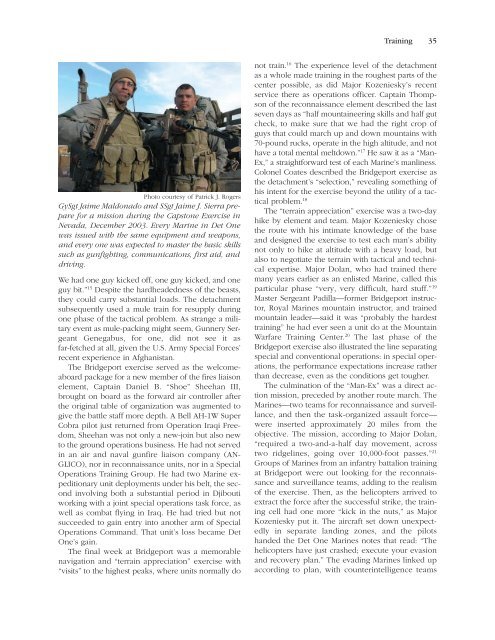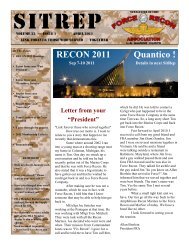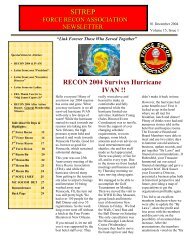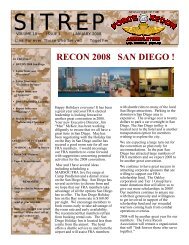Det One - Force Recon Association
Det One - Force Recon Association
Det One - Force Recon Association
Create successful ePaper yourself
Turn your PDF publications into a flip-book with our unique Google optimized e-Paper software.
Training 35<br />
Photo courtesy of Patrick J. Rogers<br />
GySgt Jaime Maldonado and SSgt Jaime J. Sierra prepare<br />
for a mission during the Capstone Exercise in<br />
Nevada, December 2003. Every Marine in <strong>Det</strong> <strong>One</strong><br />
was issued with the same equipment and weapons,<br />
and every one was expected to master the basic skills<br />
such as gunfighting, communications, first aid, and<br />
driving.<br />
We had one guy kicked off, one guy kicked, and one<br />
guy bit.” 15 Despite the hardheadedness of the beasts,<br />
they could carry substantial loads. The detachment<br />
subsequently used a mule train for resupply during<br />
one phase of the tactical problem. As strange a military<br />
event as mule-packing might seem, Gunnery Sergeant<br />
Genegabus, for one, did not see it as<br />
far-fetched at all, given the U.S. Army Special <strong>Force</strong>s’<br />
recent experience in Afghanistan.<br />
The Bridgeport exercise served as the welcomeaboard<br />
package for a new member of the fires liaison<br />
element, Captain Daniel B. “Shoe” Sheehan III,<br />
brought on board as the forward air controller after<br />
the original table of organization was augmented to<br />
give the battle staff more depth. A Bell AH-1W Super<br />
Cobra pilot just returned from Operation Iraqi Freedom,<br />
Sheehan was not only a new-join but also new<br />
to the ground operations business. He had not served<br />
in an air and naval gunfire liaison company (AN-<br />
GLICO), nor in reconnaissance units, nor in a Special<br />
Operations Training Group. He had two Marine expeditionary<br />
unit deployments under his belt, the second<br />
involving both a substantial period in Djibouti<br />
working with a joint special operations task force, as<br />
well as combat flying in Iraq. He had tried but not<br />
succeeded to gain entry into another arm of Special<br />
Operations Command. That unit’s loss became <strong>Det</strong><br />
<strong>One</strong>’s gain.<br />
The final week at Bridgeport was a memorable<br />
navigation and “terrain appreciation” exercise with<br />
“visits” to the highest peaks, where units normally do<br />
not train. 16 The experience level of the detachment<br />
as a whole made training in the roughest parts of the<br />
center possible, as did Major Kozeniesky’s recent<br />
service there as operations officer. Captain Thompson<br />
of the reconnaissance element described the last<br />
seven days as “half mountaineering skills and half gut<br />
check, to make sure that we had the right crop of<br />
guys that could march up and down mountains with<br />
70-pound rucks, operate in the high altitude, and not<br />
have a total mental meltdown.” 17 He saw it as a “Man-<br />
Ex,” a straightforward test of each Marine’s manliness.<br />
Colonel Coates described the Bridgeport exercise as<br />
the detachment’s “selection,” revealing something of<br />
his intent for the exercise beyond the utility of a tactical<br />
problem. 18<br />
The “terrain appreciation” exercise was a two-day<br />
hike by element and team. Major Kozeniesky chose<br />
the route with his intimate knowledge of the base<br />
and designed the exercise to test each man’s ability<br />
not only to hike at altitude with a heavy load, but<br />
also to negotiate the terrain with tactical and technical<br />
expertise. Major Dolan, who had trained there<br />
many years earlier as an enlisted Marine, called this<br />
particular phase “very, very difficult, hard stuff.” 19<br />
Master Sergeant Padilla—former Bridgeport instructor,<br />
Royal Marines mountain instructor, and trained<br />
mountain leader—said it was “probably the hardest<br />
training” he had ever seen a unit do at the Mountain<br />
Warfare Training Center. 20 The last phase of the<br />
Bridgeport exercise also illustrated the line separating<br />
special and conventional operations: in special operations,<br />
the performance expectations increase rather<br />
than decrease, even as the conditions get tougher.<br />
The culmination of the “Man-Ex” was a direct action<br />
mission, preceded by another route march. The<br />
Marines—two teams for reconnaissance and surveillance,<br />
and then the task-organized assault force—<br />
were inserted approximately 20 miles from the<br />
objective. The mission, according to Major Dolan,<br />
“required a two-and-a-half day movement, across<br />
two ridgelines, going over 10,000-foot passes.” 21<br />
Groups of Marines from an infantry battalion training<br />
at Bridgeport were out looking for the reconnaissance<br />
and surveillance teams, adding to the realism<br />
of the exercise. Then, as the helicopters arrived to<br />
extract the force after the successful strike, the training<br />
cell had one more “kick in the nuts,” as Major<br />
Kozeniesky put it. The aircraft set down unexpectedly<br />
in separate landing zones, and the pilots<br />
handed the <strong>Det</strong> <strong>One</strong> Marines notes that read: “The<br />
helicopters have just crashed; execute your evasion<br />
and recovery plan.” The evading Marines linked up<br />
according to plan, with counterintelligence teams






